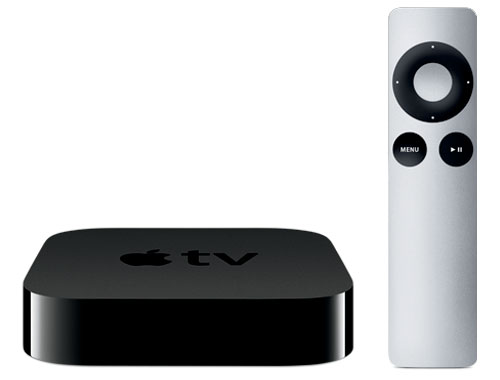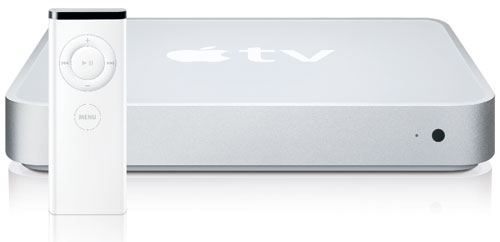Hosted by site sponsor WebMate.
Apple TV Q&A
Update Published October 10, 2017
Also see: All Apple Q&As >> Apple TV Q&A (Home)
To be notified of new Q&As, sign up for EveryMac.com's bimonthly email list.
What are the differences between the original Apple TV and the Apple TV 2nd Gen? Is one still worth buying?
Please note that both the original Apple TV and the Apple TV 2nd Gen have been discontinued. However, this Q&A has been updated subsequently and can be quite useful for anyone considering either of these models on the used market.
Both the original Apple TV and black second generation Apple TV are branded "Apple TV" and are designed to be connected to a television to support content. Other that that, however, there are few similarities in hardware, software, and functionality.
External Differences
With even a quick glance, it is obvious that the black second generation Apple TV is externally quite different from the original Apple TV. The black second generation model uses a truly tiny 3.9 inch by 3.9 inch by 0.9 inch case in black that resembles a hockey puck and ships with an aluminum Apple Remote.

Photo Credit: Apple, Inc. (2nd Generation Apple TV)
The original Apple TV, on the other hand, uses a relatively large 7.7 inch by 7.7 inch by 1.1 inch gray case and shipped with an white plastic Apple Remote. It is worth noting that although the newer aluminum remote is attractive, some vastly prefer the "play/pause" button in the middle design that the older white plastic remote provides. Both remotes will work with either device.

Photo Credit: Apple, Inc. (Original Apple TV)
Connectivity Differences
Connectivity is different as well as external design. Both models have an optical audio out port, an HDMI port, a 10/100Base-T Ethernet port, and support 802.11a/b/g/n "AirPort Extreme" wireless networking. However, the original Apple TV also has a full-size USB 2.0 port, analog audio out ports, and component video out ports, whereas the second generation Apple TV does not. The second generation Apple TV does, however, have a Micro-USB port "for service and diagnostics" (and hacking, no doubt).
The second generation Apple TV also supports Dolby Digital 5.1 surround sound via pass-through whereas the original model only outputs a Dolby Prologic stereo signal. Power consumption is considerably different as well, as the original Apple TV uses 48 watts and the second generation model only uses 6 watts.
Identification Differences
Although visually identification is simple for these two models based on color and size, it is not for other Apple TV models. Consequently, additional help with differentiation can be useful.
The original Apple TV uses model number A1218 and the second generation Apple TV uses model number A1378. Both of these identifiers are listed on the bottom of each respective device.
To pinpoint a specific Apple TV by other identifiers, please refer to EveryMac.com's Ultimate Mac Lookup feature.
Internal Differences
Internally, the differences between models are perhaps even more substantial than the external differences.
The original Apple TV essentially is a low-end Intel PC (compared to other systems available upon its introduction). Apple officially only notes that it has an "Intel processor," but as first revealed by AnandTech, it is more specifically powered by a 1 GHz Ultra Low Voltage Pentium M based on the Dothan core with a 400 MHz frontside bus and 2 MB of level 2 cache. It has 256 MB of onboard RAM. For graphics, it uses an onboard NVIDIA GeForce Go 7300 graphics processor with 64 MB of GDDR3 SDRAM and for storage it has a 40 GB or a 160 GB hard drive.
The second generation Apple TV, by contrast, essentially is internally a fourth generation iPod touch without the display. Like its predecessor, Apple officially only notes the processor type -- an Apple A4 -- but iFixit tore apart the second generation model and discovered more details.
Just as it is for the iPod touch 4th Gen, the Apple A4 processor in the second generation Apple TV has a maximum clockspeed of 1 GHz and it commonly runs around 750 MHz to 800 MHz. The second generation Apple TV has integrated graphics and 256 MB of onboard RAM, and although it officially has no internal storage, it has 8 GB of flash RAM to act as a buffer during streaming. It is all but certain that this 8 GB of flash RAM will be used by creative hackers for storage as well.
OS Differences
The operating system used by each model is completely different. The original Apple TV uses software similar to the Mac OS X application Front Row, and it runs a scaled down version of "OS X," but it was not designed to run the full version of Mac OS X. It was hacked to do so, however.
The second generation Apple TV, by contrast, runs a variant of the iOS that powers the iPod touch and iPhone models. It was pre-installed with a modified version of iOS 4.1 and cannot be updated beyond Apple TV Software Update 6.2.1. It is not capable of running standard iOS applications or the later "tvOS."
Functionality Differences
Although both support 720p video, even the basic functionality of each device is quite different. The original Apple TV requires one to sync it to a Mac or PC and makes it possible to wirelessly stream iTunes content -- "music, audiobooks, videos, TV shows, and movies" -- from as many as five Macs or PCs to an EDTV or HDTV (as well as a limited number of SDTV sets). It also can store as many as 50 or 200 hours of video -- on the 40 GB or 160 GB hard drive -- respectively, as well as music and photos. On January 15, 2008, Apple also added the ability to rent movies directly from the original Apple TV.
The second generation Apple TV, by contrast, is a much simpler device. It only works with HDTV sets with an HDMI port, does not have any advertised internal storage and cannot store any video, audio, or photo content. It does not require one to sync it to a Mac or PC.
By contrast, it just streams content from a Mac or PC, an iPhone, iPod touch or iPad (if running iOS 4.2 or later) and initially allowed one to rent (and later buy) movies, in addition to TV shows, from Apple. It has built-in support for Netflix, YouTube, Flickr and MobileMe streaming as well. Neither generation Apple TV has an optical drive to play CDs or DVDs and neither can record television programs.
Comparison Chart
These differences are summarized below for your convenience:
 Original Apple TV |
 2nd Gen/Black Apple TV |
|
|---|---|---|
| Processor Type: | Pentium M | Apple A4 |
| Processor Speed: | 1 GHz | 1 GHz* |
| Standard RAM: | 256 MB | 256 MB |
| Standard VRAM: | 64 MB | Integrated |
| Video Type: | NVIDIA GeForce Go 7300 | Integrated |
| Hard Drive: | 40 GB, 160 GB | None |
| Flash Memory: | None | 8 GB** |
| Optical Drive: | None | None |
| USB Ports: | 1 (2.0) | 1 (Micro-USB) |
| Display Ports: | HDMI, Component | HDMI |
| Audio Ports: | Optical, Analog | Optical |
| 5.1 Surround Sound: | No | Yes |
| SD Card: | No | No |
| Sync Required: | Yes | No |
| Stream Content: | Yes | Yes |
| Store Content: | Yes | No |
| Recording Capability: | No | No |
| Dimensions (In): | 7.7" x 7.7" x 1.1" | 3.9" x 3.9" x 0.9" |
| Power Consumption: | 48 Watts | 6 Watts |
| Case Material: | Polycarbonate/Steel | Polycarbonate |
| Case Color: | Gray | Black |
| Apple Order No: | MA711LL/A, MB189LL/A | MC572LL/A |
| Apple Model No: | A1218 | A1378 |
| EMC No: | 2123 | 2411 |
| Original Price: | US$299, US$399 | US$99 |
* This processor has a maximum clockspeed of 1 GHz and it commonly runs around 750 MHz to 800 MHz.
** The second generation Apple TV has 8 GB of flash RAM to act as a buffer during streaming. It is not designed for use as storage.
So, which one is best for me? Is one still worth buying?
When it was first released, the market largely dismissed the original Apple TV due to its high price tag compared to a much more capable Mac mini at the time, but on the used market, it has its fans as it is so much more "open" than later models in many respects. The Apple TV 2nd Gen has been jailbroken and is a favorite among the jailbreak community and it has became quite popular in this niche market.
If you need a way to stream content from a Mac or PC (or your iPod touch, iPhone or iPad), to your HDTV as well as stream Netflix, YouTube, Flickr and MobileMe content, and/or are interested in renting content from Apple, the second generation Apple TV officially makes it simple. It also has a wide variety of capabilities added by the creative jailbreaking community.
If you would rather store content that you own -- or you have an older television without an HDMI port -- perhaps the original Apple TV still is worth consideration. For those interested in a vastly more powerful -- but likewise much more expensive -- option, it also is simple to connect an Aluminum Mac mini to an HDTV.
Also see:
- What are all the differences between the Apple TV 2nd Gen and Apple TV 3rd Gen? How many of these models are there? Is one of these older models still worth considering?
- What are all the differences between the Apple TV 3rd Gen and Apple TV 4th Gen (Siri) models? Which is best for me?
- What are all the differences between the current Apple TV 4th Gen (Siri) and Apple TV 4K models? Which is best for me?
Permalink | Report an Error/Typo | Sign Up for Site Update Notices
Established in 1996, EveryMac.com has been created by experts with decades of experience with Apple hardware. EveryMac.com includes, and always has included, original research incorporating detailed, hands-on inspection of packaging, computers, and devices as well as extensive real-world use. All information is provided in good faith, but no website or person is perfect. Accordingly, EveryMac.com is provided "as is" without warranty of any kind whatsoever. EveryMac.com, and the authors thereof, shall not be held responsible or liable, under any circumstances, for any damages resulting from the use or inability to use the information within. For complete disclaimer and copyright information please read and understand the Terms of Use and the Privacy Policy before using EveryMac.com. Copying, scraping, or use of any content without expressed permission is not allowed, although links to any page are welcomed and appreciated.
